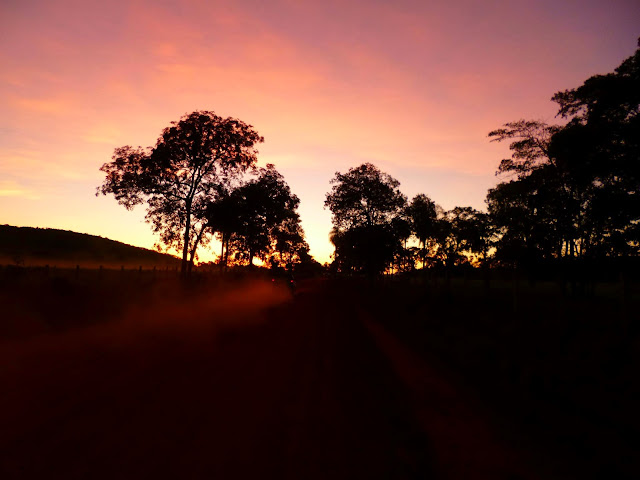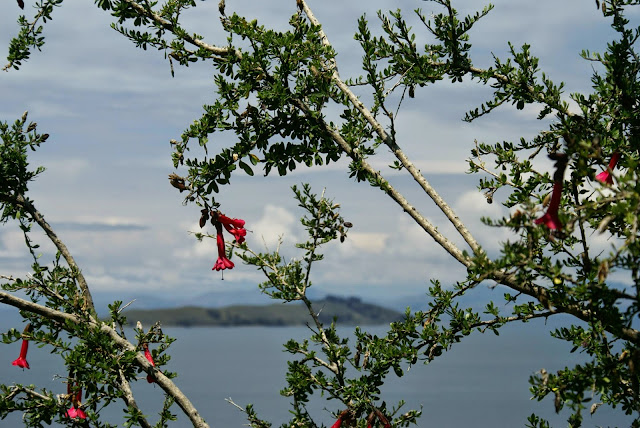So off I trotted with my backpacks on front and back onto the rather luxurious night bus (only 3 seats per row!) which would take me to the Brazilian border. I knew that I had some vague calling points that I wanted to reach, but apart from that I was pretty much heading off for ten weeks on my own with no plan and no one to sort things out if things go tits up. Such freedom is exciting and daunting in equal measures, especially when your first stop is the 5th largest country in the world, where you don't speak a word of their language, and they most likely don't speak a word of yours.
The whole experience was improved by meeting an Irish woman called Laura, introduced to me in the immigration queue by a couple of tour touts as being from my country as well (close but no cigar mate). She too was leaving someone behind and striking out on her own, so we struck up a friendship. That friendship turned out to be instantly useful as she, being a more experienced traveller, expertly played two desperate agencies off against each other to sort us out highly reduced transportation to our shared destination of the aptly-named Bonito in the southern pantanal. I was definitely taking mental notes.
Even in the few hours we spent in that downbeat border town was enough to notice a few details that mark out Brazil as a bit different to the countries I'd previously been to, and perhaps part of the reason why many Brazilians don't consider themselves latinos, and instead some kind of race of their own:
The obvious one - the language. I'd always known that people speak Portuguese in Brazil but didn't truly accept it as a fact until I arrived there and realised that they actually speak Portuguese. But they do, so I had to get used to it. At first listen it comes across a bit abrasive, but with a bit of understanding it's actually a lovely melodic language, muito bonito as they would say. My Spanish was good enough at that stage for them to understand me if I spoke slowly enough, and the similarities are close enough that I could understand them to an extent when they replied. If they spoke slowly enough.
The food. Sitting down for a buffet lunch it was clear the difference in freshness, colour and quality between Brazil and other Latin countries I'd visited. Interesting salads, rich bean stews and creamy fish curries were highlights in a buffet in which every single thing available was tasty and fresh. Brazil is famous for its per-kilo lunches, and with good reason.
Manners. This is obviously a subject close to my heart, being a Brit. I remember the first time I crossed the street and the car approaching actually slowed down instead of speeding up to see if it could force me to run like a girl. This is symptomatic of a more relaxed attitude which isn't in constant competition with all those around it for bus seats or oxygen.
Other things I noted upon arriving: the money in Brazil has to be amongst the most beautiful and colourful in the world, decorated with the faces of native animals. Oh and it's pretty hot and the women are improbably dimensioned, but you already knew that.
First stop in Brazil, then, was Bonito in Mato Grosso do Sul, in the south of the flood plains of the pantanal region. Being in Brazil and being an ecotourism hotspot without comparison for hundreds of miles, it is not only bonito but also Expensive with a capital E. I stayed at the very nice HI hostel, where I discovered a great Brazilian tradition on our first morning there - cake for breakfast! Those big gleaming chocolatey creations were something that I would come to miss greatly when I finally left.
The first day took Laura and I to gruta azul, a steeply-sloping cave where the water appears to be a pure blue due to a cunning trick of the way the light comes in. It set us each back around 25 quid for an hour's tour, plus another 25 between two for taxi there and back, and that was the cheapest option in all Bonito...
Nevertheless, the cave was very sweet, and started me on my love affair with the Portuguese language. It turns out that stalagmite in Portuguese is pronounced like 'stalag-mee-chee' and stalactite like 'stalag-tee-chee' - adorable. It sounded hilarious coming from the mouth of a butch Brazilian bloke.
In the afternoon we cycled many a mile on hot dusty roads to reach a local relaxation water park thing, with a zip line especially designed for you to drop from a height into the natural pool, then played table tennis whilst being watched by a moody macaw, and finally cycled back to yet another incredible sunset in this continent. I swear I've seen so many that you could almost become blasé about it. I wasn't and am not and I'm amazed by it every time.
After a disappointing attempt to discover some Brazilian-style party, we coughed up the 50 notes the next day to do a snorkelling tour of Rio da Prata (silver river). This was great - not only did we have a Steve Carell lookalike for a guide (see below), but we spent a good couple of hours floating down a nice warm river which was the closest thing I'd experienced to swimming through an actual fish tank. Incredibly clear water and incredibly close to all sorts of tropical fish. The best bit was my first sighting of a monkey in the wild, swinging around and showing off as we floated by. A true Brazilian classic.
The final full day of my Bonito experience finished with Laura and I entertaining some of the hostel guests with a few ramshackle versions of the likes of Hallelujah and Sunday Bloody Sunday. My final full day in this leg of Brazil was not so happy, as I was lied to and thus overcharged by a taxi driver in the border town of Ponta Pora about buses to Paraguay, misled about available hotels when I was forced to stay the night in that horrible place, and almost led into the clutches of some delinquents who I swore were going to pull a knife on me. Perhaps Brazil does have some latino qualities after all...















































